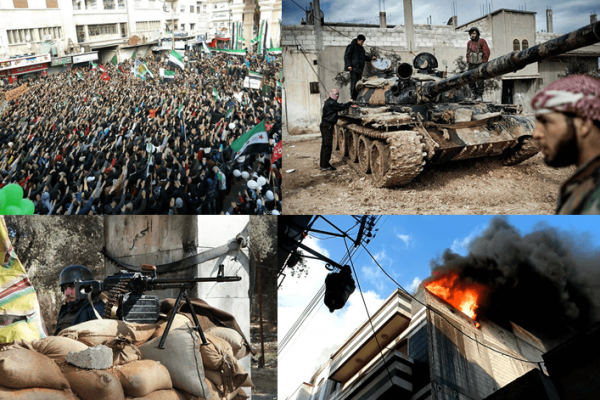Fake news by design
Mainstream news media reporting and the manufacture of bloodbaths in Libya and Syria
Destabilizing Syria
When covering the Syrian War that erupted shortly after the March 2011 uprising against the Bashar al-Assad government, the Western news media adopted the same model that they had institutionalized during their reporting on Libya. The news media narrative on Syria drew heavily from second-hand evidence provided by official Western as well as Syrian opposition sources. News media propaganda emphasized the culpability of the Syrian government almost like a monolith. The fact that Western states and their allies had provided significant aid to the opposition—policies that destabilized Syria and further fueled the conflict—was ignored.
On 21 April 2012, the United Nations had tasked a 90-day monitoring mission in Syria to broker a ceasefire between Syrian government and opposition forces as well as to implement a six-point peace plan to end the conflict, put forward by the then-Special Envoy to Syria, Kofi Annan. Following its implementation, the peace plan had led to an initial decrease in violence. On 25 May 2012, about 116 civilians were slaughtered in the Syrian village of Taldou, which is located in the Houla region in western Homs. The so-called Houla massacre rekindled the conflict and this led to a suspension of the UN peace plan in August 2012. Moreover, Houla constituted the first major event that shifted international attention towards “humanitarian intervention” in Syria.
Two competing political narratives about the Houla incident should emerge: (1) According to Western officials and Syrian opposition activists, the Assad regime and its paramilitary forces—the Alawite Shabiha militias—had conducted a sectarian killing of Sunni Muslim civilians. (2) The Syrian government, on the other hand, had blamed opposition militants for the killings. The news media highlighted the first narrative whilst marginalizing the perspective of the Syrian government and its allies. This was striking since even about three weeks after the Houla massacre took place, Major General Robert Mood, then-Head of the United Nations Supervision Mission in Syria, said the facts and circumstances relating to the incident remained unclear and pointing to conflicting local witness testimony.
Moreover, there were important contextual factors. As Patrick Cockburn stated in a report for the Independent on May 27, 2012, the Houla “massacre could mark a crucial stage in the war in Syria because it will energize the insurgents inside and outside the country” and will also “underline that the ceasefire arranged by the UN-Arab League envoy Kofi Annan is foundering.” Additionally, in another article published a day earlier, Cockburn discussed how the ceasefire related to the war parties and the Houla event:
The ceasefire was only sporadically implemented from the beginning. The government has always had more interest in its successful implementation, which would stabilise its authority, than the insurgents, who need to keep the pot of rebellion boiling. The UN monitoring team says that during the ceasefire “the levels of offensive military operations by the government significantly decreased” while there has been “an increase in militant attacks and targeted killings”. But any credit the Syrian government might be hoping for showing restraint will disappear if the latest atrocities are confirmed.
If Cockburn’s statements were accurate, then the Houla massacre could have destabilized the Syrian government’s prospects under the ceasefire. Furthermore, as observed by the UN monitoring team cited by Cockburn, not the Syrian government but factions of the opposition had actually increased their militant attacks, which included targeted killings. And the Houla incident was mainly comprised of targeted killings. These contextual factors could at least have cautioned the news media about assigning culpability for the Houla massacre to the Syrian government.
Yet, the news media prominently carried indignant statements by Western official and Syrian opposition actors who demanded international intervention against the Assad-government. This discourse included discussions about the implementation of military policies, such as the imposition of a no-fly zone, as well as various political measures ranging from regime change operations, sanctions and aid for the opposition to demands for independent investigations and the referral of Syria to the International Criminal Court (ICC).
Significantly, my study found that eleven major national US, UK and Germany newspapers published 262 items during the first two-weeks of coverage after Houla, of which 133 (50.7 per cent) included statements mentioning or discussing some form of military intervention in Syria. On the other hand, the news media was hardly able to interrogate critically the goals of the Syrian opposition—which already in November 2011 had asked for foreign intervention—and its Western and Arab state supporters.
The news media only rarely provided analysis that cast a negative light on the Syrian opposition. For instance, a critical op-ed comment by Patrick Seale in the Guardian on 27 May argued: “The strategy of the armed opposition is to seek to trigger a foreign armed intervention by staging lethal clashes and blaming the resulting carnage on the regime.” That the Houla massacre fit well into such a pattern was hardly a concern for the news media.
In conclusion, it would not be surprising if the hyper-militarist discourse featured in the news media was, in fact, detrimental to the goals of the UN peace plan and contributed towards escalating the conflict in Syria.

